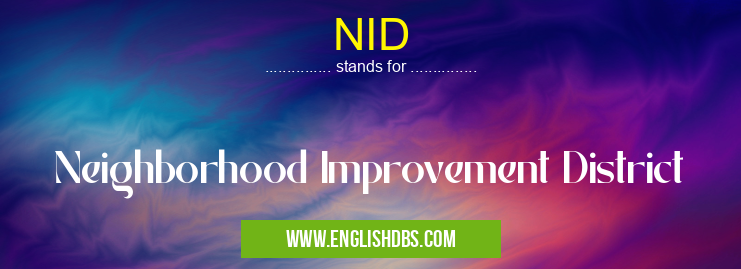What does NID mean in COMMUNITY
A Neighborhood Improvement District (NID) is a special district created by local governments to promote the improvement and development of a specific area within their communities. NIDs are typically funded through public financing or assessments on area property owners, and they provide resources for projects such as infrastructure improvements, public safety measures, beautification initiatives, and other activities designed to enhance the quality of life in the designated area. A successful NID program can result in increased economic investment, improved public safety, greater neighborhood pride, and general enhancement to the quality of life in the community.

NID meaning in Community in Community
NID mostly used in an acronym Community in Category Community that means Neighborhood Improvement District
Shorthand: NID,
Full Form: Neighborhood Improvement District
For more information of "Neighborhood Improvement District", see the section below.
What Does It Mean?
An NID is essentially a collaboration between local governments and property owners seeking to improve an area in their community. The funds generated from taxes or assessments paid by property owners are used to finance projects such as installing sidewalks, street lighting, or upgrading parks. Additionally, many NIDs create committees made up of citizens from the area who help decide where funds should be allocated and what improvements should be made within their neighborhood.
Advantages of Neighborhood Improvement Districts
Neighborhood Improvement Districts offer numerous advantages for communities. They are an effective way for local governments to bring together property owners with common interests in order to facilitate improvements that all parties support. Additionally, residents often benefit directly from improvements made in their neighborhoods such as lower crime rates, improved schools and recreational facilities, or enhanced public services like garbage collection and snow removal. Furthermore, businesses are more likely to invest in an area when they know there will be continued support from local government initiatives like NIDs since they perceive it as a sign that the region is stable and growing.
Essential Questions and Answers on Neighborhood Improvement District in "COMMUNITY»COMMUNITY"
What is a Neighborhood Improvement District (NID)?
A Neighborhood Improvement District (NID) is a special assessment district initiated by the property owners in an area to pay for improved services or amenities such as security, beautification, and streetscape improvements.
Are NIDs voluntary?
Yes, NIDs are completely voluntary. Property owners may decide whether or not to participate in creating and funding an NID depending on their own individual needs and preferences.
How many people must form an NID?
The formation of an NID requires agreement from at least 50% of the landowners in the designated area plus approval of the local governing body.
Who operates NIDs?
An NID board, composed of participating landowner representatives, manages day-to-day operations of the district. This board typically works with the local government to ensure that public safety requirements are met.
How does funding for an NID work?
Funding for an NID generally comes from assessment fees levied on participating property owners. These funds are then used to provide additional services such as enhanced security or street maintenance within the designated area.
Is there a limit to how much money can be raised through assessments?
Each individual assessable property cannot be assessed more than 20 percent of its taxable value as determined by the county assessor's office. Additionally, total annual assessments within any one neighborhood improvement district shall not exceed 33⅓ percent of all taxable value within that district on all assessable parcels combined.
Does every participating owner have to pay assessments?
Yes, each owner who has expressed support for the formation and funding of an NID will be subject to assessment in accordance with their percentage ownership interest in their respective properties.
Can assessments be adjusted over time according to need?
Yes, depending on changing conditions or new goals being set out for the district, assessment rates may be increased or decreased accordingly.
Do all members vote equally when making decisions related to the NID?
No, voting power is allocated based on individual assessment amount allocated so that those contributing more have proportionately greater influence regarding decision-making within the district.
Final Words:
In conclusion, Neighborhood Improvement Districts are advantageous for both residents and businesses alike as they allow local governments to collaborate with their citizens on projects designed to enhance conditions within their neighborhoods while bringing economic growth opportunities at the same time. Communities reap benefits such as improved safety features, upgraded facilities and services; businesses gain confidence that investing in an area will result in long-term returns; while all stakeholders involved gain satisfaction knowing they’re making positive changes for everyone within the defined boundaries of a particular area. With these benefits combined together any community would do well in considering establishing its own Neighborhood Improvement District.
NID also stands for: |
|
| All stands for NID |
